By Jeffrey A. Rendall, Photos By Jeffrey A. Rendall
CLIFTON, VA (January, 2003) -- Sometimes you have to wonder -- what'll happen to that ball you just plunked in a lake? Sure, you figure it'll be resurrected at some point, pulled from its watery grave by some guy in a wetsuit, diving mask and fishnet bag full of others' mistakes.
Then it'll probably find its way to the 'experienced ball' basket in the pro shop or a golf discount store. Reintroducing it into the game's chain-of-play is somewhat risky, however; according to some studies, the 'second coming' reduces the ball's performance, since the core and cover's molecular properties alter with the passage of time down below. You'll pay less to repurchase 'em, but your distance stats and putting accuracy may suffer.
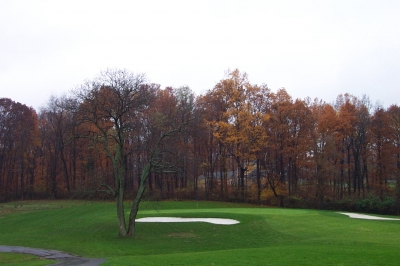 |
| The Lakes Course's 4th green is the smallest on the course, and makes for a difficult target to hit. |
Maybe there's a better way to use them -- perhaps even as 'foundations' for playing the game itself.
To see an example of a new and creative alternative for recycled surlyn and rubber bands, check out the Lakes Course at Fairfax County's Twin Lakes Golf Facility. Peter Furey, Twin Lakes' Manager, explains: "Because of this year's drought (2002), we realized we needed to deepen the lakes on the course to provide additional water storage for future considerations."
Furey continues, "We've also needed to add additional tee boxes to the Lakes Course to make it a bit more friendly for ladies and shorter hitters. So we constructed some new tees out of the dredged soil we took from the lakes. And when the dozers were pushing the soil, it was very interesting to see all the white and orange golf balls that were pulled from the bottom. The sludge almost looked like a chocolate chip cookie with M & M's."
"We've put plenty of tee mix on top of the material, so no one will ever know exactly what's down there -- but essentially they'll be teeing on top of other people's 'disasters.' Almost like playing over bones in a cemetery," Furey mused.
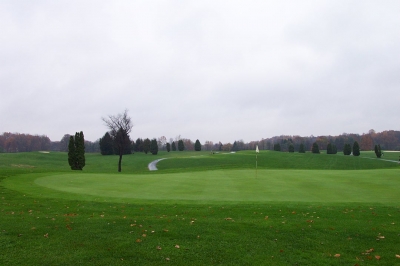 |
| The par three 6th hole used to be a par five under the previous configuration. Now it's a long but straightforward test. |
Hardly full of 'grim' situations, the Lakes Course is a local favorite because it's very wide open, and extremely playable. Opening in 1967, the Charles Schalestock design occupies the site of an old farm, and even includes a barn from the bygone era. Twin Lakes doubled in size in 1998 with the opening of the Oaks Course, and although both layouts occupy the same property, they're actually quite different.
The Oaks Course, as the name suggests, plays down tree-lined corridors. The Lakes, as its name suggests, features a pair of lakes that bisect the property, and offers an open routing over gently rolling terrain. When the decision was made in the mid-nineties to expand the facility to 36 holes, the Lakes Course changed some, too.
Furey elaborates: "The Oaks Course was designed and built outside the confines of the Lakes Course, so we didn't use any of the new holes -- but in order to accommodate the new clubhouse (which is now on the west side of the property's lakes), we built or modified a total of six holes."
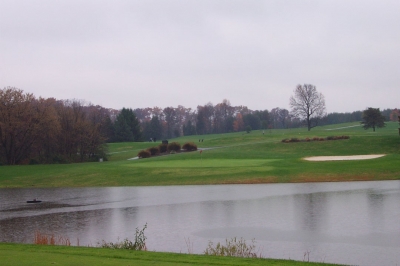 |
| The 187 yard, par three 8th hole hasn't changed from the old days, but that doesn't make it any easier to carry the water. |
And, the changes are: "Number four is an old par five that was strengthened and improved; five is brand new; six is where the old second hole was, and we reduced it from a par five to a par three. On the back, the par five thirteenth took the place of the old number one; fourteen's a par three with new tee and green locations; and fifteen is the only hole that was cut from a virgin tree growth area," Furey said.
Furey indicated they didn't want to put all the new 'work' in one sequence, and by breaking up the new construction, they've allowed the continuity of the routing to remain intact. One other modification is planned -- changing the finishing short par five 18th into a long par four. The Lakes Course plays to 6788 yards and a par of 73 -- and making the eighteenth hole a bit shorter and chopping off one stroke from par will help the layout conform with modern standards for yardage and par.
The Lakes Course plays very much in the old style of golf courses, and is a no-frills but very enjoyable layout. Being a core golf course, there are no homes bordering the fairways, and it contains panoramic sight lines in virtually every direction. From the high points on the property, you'll see much of the layout, and the ups and downs of the terrain provide serene topographical variety.
The slope rating of 132 from the back tees seems about right, and provides just enough challenge to keep it interesting, and enough scoring chances to make it exciting.
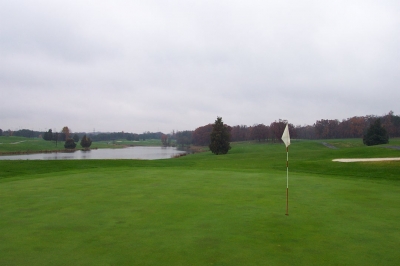 |
| The 431 yard, par four 12th hole used to be the closing hole before the changes were made. You'll be glad when this sequence is complete. |
Furey puts the Lakes Course in his own words: "It's obviously a wide-open design, but what I hear most from golfers is that it's an enjoyable course. Since it's open, you can pretty much find your ball fairly easily on most holes. From the tips, you can still challenge your game. It's a bit long for a lot of the ladies (5627 yards from the forward tees), so they tend to prefer the Oaks Course, but with our new improvements, that'll chip away at the difference."
"We've got some pretty tough holes, and some fairly easy ones. Take for example the first three holes on the back nine. On the old configuration, those were the closing three holes, and we've had some very good golfers say they were three of the toughest finishing holes in the area. Now they're in the middle of the course, and it's interesting to see the new mindset that you're in, playing those holes at the beginning of the backside. A lot of good rounds bite the dust around that little turn," Furey said.
The Lakes Course adds difficulty in different areas than most golf courses these days. Whereas you'll usually find a few mild carries on virtually every layout you see, the majority of challenging shots stem from placing shots accurately between hazards. You'll need both length and accuracy on the Lakes Course. You certainly won't find yourself horizontally challenged very often, but a few of the carries will instill some fright if you can't accurately place shots.
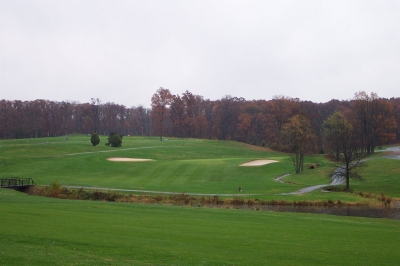 |
| If you're in the wrong spot off the tee of the 407 yard 2nd hole, this carry over the lake will look pretty tough. |
A good example is the second hole, a 407 yard par four, rated the number two handicap hole. From the tee, a lake runs down the right side of the driving landing area, and then crosses the fairway. The hole doglegs right and up a gentle slope from there. If you go too far right off the tee, you'll challenge the water, and the fairway slopes in that direction. Miss left and you're in thick rough, facing a daunting carry over the water.
There are also substantial carries on the eighth hole, a 187 yard par three over the lake; the tenth hole, a 414 yard par four with the approach over water (similar to the second); the eleventh hole, a 208 yard par three, again with virtually a full carry; and thirteen, a par five, with a ravine to fly off the tee.
The Lakes' greens are large and reasonably flat, and as you'd expect, won't roll at speeds reflective of a lucrative private club. But one aspect of the greens complexes is somewhat unique to the course. Furey explains, "The bunkers on the Lakes Course are mostly higher than the greens, so you're actually hitting from an elevated trap down to or across to the pin position. I'd played here for years and never really noticed it, then Denis Griffiths (the architect brought in to design the Oaks Course and the Lakes' remake) pointed it out. They're difficult bunkers to gauge, because you're not hitting straight up like most sand bunkers you'll see."
Highlights on the Lakes Course include number four, a 527 yard par five that parallels a road to the right side. Furey said they purposely put more bunkers on the right side of the hole to try and steer shots away from the road, making the hole play longer than its yardage. The third shot is especially difficult, as you'll need to avoid bunkers on either side of the putting surface, and the green is the smallest on the course.
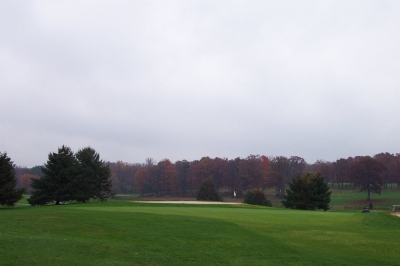 |
| The 477 yard, par five 9th hole is one of several short par fives where you'll have a chance to make a good number. |
The aforementioned eighth hole is a picturesque par three, with a 187 yard carry over water. The tee box is angled to provide shorter distances for the different tee boxes -- a creative design feature.
On the inward nine, the eleventh hole (208 yards, par three) is as beautiful and difficult as you'll see anywhere. It does play slightly downhill, but if you're short, right or left, you're either reloading or in a bad situation.
Thirteen is an interesting par five. At 509 yards, you'd think long hitters would salivate at the chance to go at it in two. But the hole doglegs sharply left nearer the green, being tucked into a corner that protects it well. It's a relatively easy par, but not quite the sure birdie chance the scorecard would suggest.
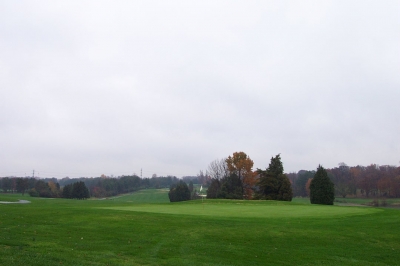 |
| When converted to a par four, the 451 yard 18th hole will morph from a pussycat into a lion. |
Eighteen plays only 451 yards (par five), with a downhill tee shot and slightly uphill approach. Furey says, "Of all the holes out here, eighteen receives the most comments from our players. They say it should be a difficult, long par four instead of a gimme par five. In order to do that, we needed to add some forward tees to make it more reasonable for folks playing from the gold and red tees. When complete, it'll be a memorable closing hole."
One other aspect of the Twin Lakes experience that leaves a lasting impression is its clubhouse. "People come in to the clubhouse, and they're taken aback. They can hardly believe this is a public, municipal golf course. The architect did a great job with its location, and we're very pleased with the way things turned out," Furey added.
That'll be the general impression most folks will take away after playing Twin Lakes -- being pleased. It's a good buy for the money, a solid golf outing without a lot of frivolity. What else would you expect from a course resting on a bed of golf balls?
Note: You can easily walk both the Lakes and Oaks Courses at Twin Lakes, and it's highly recommended from this reviewer.
Details:
The Lakes Course At Twin Lakes
6201 Union Mill Road
Clifton, VA 20124
Phone: (703) 631-9099; Tee Times: (877) 776-3272
FAX: (703) 803-6239
Website: www.co.fairfax.va.us/parks/golf/twingolf.htm
Manager: Barbara Cosgrove (Peter Furey is now with Fairfax County Recreation & Parks)
Course Architect: Charles Schalestock
| Tees | Yardage/Slope | Rating |
| Blue | 6788/132 | 72.0 |
| White | 6461/126 | 70.8 |
| Gold | 6060/121/125 (ladies) | 69.0/74.5 (ladies) |
| Red | 5627/119 | 70.7 |
Rates:
Mon-Thurs: $27 (walking), $18 for nine.
Fri-Sun: $34 (walking), $22 for nine.
Power carts are $13 a player. For nine holes, it's $8.50. Fee for range balls.
| Related Links | Comments on this article? | |
|
Maryland National Golf Club Hollow Creek Golf Club Rocky Gap Resort PB Dye Golf Club in Ijamsville Whiskey Creek Golf Club |
E-mail Jeff Rendall, Editor: jrendall@golftheunitedstates.com |












